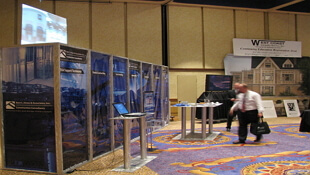Ireland Said to Plan Home Loans Limits to Prevent Bubble
October 01, 2014 —
Joe Brennan – BloombergIreland’s central bank plans to impose limits for the first time on how much banks can lend home buyers as real estate values soar again in the home of western Europe’s worst property collapse, two people with knowledge of the matter said.
The regulator is preparing to publish a consultation paper on its proposals within weeks, said one of the people, who asked not to be named, as the matter is private. Banks and lobby groups will have a chance to comment on the plans, which center on introducing loan-to-value and loan-to-income restrictions. A spokesman for the central bank in Dublin declined to comment.
Irish homes prices are surging even as banks grapple with the aftermath of mortgage crisis that forced the government to bail out most of the nation’s lenders. A quarter of the country’s owner-occupier home loans are in arrears or had their terms eased. Loans granted during the boom for more than 85 percent of the property value were most likely to default in the wake of the crash, central bank economists said today.
Read the court decisionRead the full story...Reprinted courtesy of
Joe Brennan, BloombergMr. Brennan may be contacted at
jbrennan29@bloomberg.net
Four Common Construction Contracts
August 26, 2015 —
Garret Murai – California Construction Law BlogLike Baskin Robins, construction contracts come in a variety of different flavors although, thankfully, significantly fewer than 31. Here are four of the more common types of construction contracts between project owners and contractors:
Fixed Price
Fixed price construction contracts, also commonly referred to as “lump sum” or “stipulated sum” contracts, are the most common types of construction contracts. As its name suggests, under a fixed price contract a contractor agrees to construct a project for a “fixed” or agreed upon price.
1.
Benefits: Fixed price construction contracts provide price predictability for project owners because absent changes in the scope of work, unforeseen conditions, or other circumstances which might cause the “fixed” price of the contract to go up or down, the contractor is required to complete the work for the agreed upon price.
Read the court decisionRead the full story...Reprinted courtesy of
Garret Murai, Wendel Rosen Black & Dean LLPMr. Murai may be contacted at
gmurai@wendel.com
Owner’s Obligation Giving Notice to Cure to Contractor and Analyzing Repair Protocol
November 23, 2016 —
David Adelstein – Florida Construction Legal UpdatesRecently, I read an informative article from another attorney addressing considerations of an owner when it receives a repair protocol in response to a Florida Statutes Chapter 558 notice of defect letter. This is a well-written article and raises two important issues applicable to construction defect disputes: 1) how is an owner supposed to respond to a repair protocol submitted by a contractor in accordance with Florida’s 558 notice of construction defects procedure and 2) irrespective of Florida’s 558 procedure, how is an owner supposed to treat a contractual notice to cure / notice of defect requirement that requires the owner to give the contractor a notice to cure a defect. This article raises such pertinent points that I wanted to address the issues and topics raised in this article.
558 Procedure–Owner’s Receipt of Contractor’s Repair Protocol
When a contractor submits a repair protocol to an owner in response to a notice of construction defects letter per Florida Statutes Chapter 558, the owner should seriously consider that protocol. The owner does this by discussing with counsel and any retained expert. The owner needs to know whether the protocol is a reasonable, cost-effective protocol to repair the asserted defects or, alternatively, whether the protocol is merely a band-aid approach and/or otherwise insufficiently addresses the claimed defects. Every scenario is different.
Read the court decisionRead the full story...Reprinted courtesy of
David Adelstein, Katz, Barron, Squitero, Faust, Friedberg, English & Allen, P.A.Mr. Adelstein may be contacted at
dma@katzbarron.com
History and Gentrification Clash in a Gilded Age Resort
October 05, 2020 —
Alex Ulam - BloombergNewport, Rhode Island, is a small New England beachfront town with a permanent population of 26,000 and an amazing collection of historic homes. Billed as “America’s First Resort,” the 350-year-old city on Aquidneck Island hosts more than 3 million tourists every year. They come for the boating, the famous folk and jazz festivals (both canceled this summer), and the architecture.
The narrow streets of the Point along the waterfront are lined with hundreds of modest homes from the early 1700s, one of the largest ensembles of colonial architecture in the country. On Historic Hill sits an assortment of grander antebellum, classical and Gothic Revival structures from the latter part of the 18th and early to mid-19th century, many built by Southern plantation owners. Newport also boasts what is probably the most opulent thoroughfare in the country, a several-mile stretch of Bellevue Avenue lined with shade trees and palatial limestone mansions built by Gilded Age robber barons and industrialists.
Read the court decisionRead the full story...Reprinted courtesy of
Alex Ulam, Bloomberg
Delaware Settlements with Minors and the Uniform Transfer to Minor Act
October 15, 2014 —
Stephen J. Milewski – White and Williams LLPAs a Delaware lawyer, one of the most frequently asked questions I get from insurance clients is: “Do all personal injury settlements with minors need to be approved by the Court?” The answer is and always has been yes. This is true regardless of the amount of the settlement. There have, however, been some recent changes under Delaware law which may help facilitate the process and even reduce the costs associated with settling small tort cases with minors. Traditionally, when settling cases with a minor, a Petition would be filed with the trial court (Superior Court) and then a hearing would be scheduled for the parties to present to the Court the terms of the settlement, explain the plaintiff’s injuries and itemize the fee breakdown. This would be the settlement approval process. After that, the plaintiff would be required to have a guardian appointed over the proceeds, which had to be approved by Chancery Court (Delaware’s Court of Equity). The purpose of this process was to ensure the settlement money going to the minor was managed properly; the net proceeds were generally placed into a bank account not to be used by the guardian or the minor until the minor reached the age of majority. To both the plaintiff, and the insurance carrier paying out the settlement, this process was burdensome and added disproportionate costs to small settlements.
Read the court decisionRead the full story...Reprinted courtesy of
Stephen J. Milewski, White and Williams LLPMr. Milewski may be contacted at
milewskis@whiteandwiliams.com
20 Years of BHA at West Coast Casualty's CD Seminar: Chronicling BHA's Innovative Exhibits
May 03, 2018 —
Beverley BevenFlorez-CDJ STAFFThe Bert L. Howe & Associates, Inc., (BHA) exhibit has been a fixture at West Coast Casualty's Construction Defect Seminar since the mid-1990's. Through the years, BHA has updated their display, but no matter what year, you could count on the BHA exhibit to provide a not-to-be-missed experience.
2008-BHA's sleek, rear projection display includes a screen that promotes the firm's capabilities that can be seen throughout the exhibit hall. This would be one of many innovations BHA has brought to the West Coast Casualty seminar.

2009-With the success of the rear screen projection, BHA adds additional monitors to provide attendees with more information about BHA.

2010-BHA adds an interpretive professional development exhibit targeted to Building Envelope issues allowing adjusters and other non-construction professionals hands on access to the systems and components at the heart of many related such claims.



2011-BHA's Swing for Charity challenge is born.

2012-Always innovating, BHA expands its rear projection and professional development offerings to West Coast attendees.

2013-BHA showcases additional capabilities with a twenty-four foot, custom, convex, immersive video experience.

2014-BHA adds an iPhone display to give a hands-on demonstration of their data collection methods.

2015-BHA's twenty-four foot , custom, convex, immersive video experience was elevated with two additional rear projection screens, reflecting BHA's newest capabilities and services.

2016-BHA dazzles attendees with their new exhibit comprised of more than 15 integrated, high definition, LCD displays. iPads are stationed on tables to conveniently demonstrate BHA's data collection processes.

2017-BHA's Swing for Charity Golf Challenge raised $2,225.00 for the National Coalition for Homeless Veterans and $1,900 for Final Salute.


Read the court decisionRead the full story...Reprinted courtesy of
Constructing a New American Dream
August 06, 2014 —
Beverley BevenFlorez-CDJ STAFFShelley D. Hutchins in Big Builder interviewed various architects and engineers to discuss the future of home design and building. Obtaining the American Dream “means having a place of sanctuary and security as well as shelter,” Hutchins wrote. “What that house looks like and how it functions is changing to accommodate different family make-ups, population and culture shifts toward denser more integrated communities, and increasingly extreme weather patterns.”
Hutchins declared, “According to experts, educators, and experimenters in the residential design and construction industry many solutions for building houses for the future involve revisiting what worked before. Combining historic research with new innovations is what will produce the best housing.”
Read the court decisionRead the full story...Reprinted courtesy of
Construction Contract Clauses Which Go Bump in the Night – Part 1
November 10, 2016 —
Garret Murai – California Construction Law BlogScope, time and cost provisions may be the most important clauses in your construction contract but they’re not the only ones which can impact your bottom line. The first in a multi-part series, here are some other important construction contract clauses you may (or may not realize you should) be losing sleep over.
Provision: Incorporation and Flow-Down Provisions
- Typical Provision: “The term ‘Contract Documents’ shall include, without limitation, the Prime Contract, drawings, specifications and other agreements between Contractor and Owner, insofar as they relate in any way, directly or indirectly, to Subcontractor’s Work under this Agreement, and are hereby incorporated by reference. Subcontractor agrees to be bound to Contractor in the same manner and to the same extent as Contractor is bound to Owner under the Contract Documents. Where, in the Contract Documents, reference is made to Contractor, and the work and specifications therein pertain to Subcontractor’s trade, craft, or type of work, such work or specifications shall be interpreted to apply to Subcontractor rather than Contractor.”
- What it Means: An incorporation provision literally “incorporates” another document or documents into a contract by merely referring to them by title or description and it is not uncommon for a lower-tiered contractor to never see those documents.
A flow-down provision requires a lower-tiered contractor to comply with all obligations which a higher-tiered contractor, typically a direct contractor, owes to a higher-tiered party, typically, the owner. The intent of the provision to ensure that a lower-tiered subcontractor has no greater rights against a direct contractor has against the owner.
- What You Can Do: Lower-tiered contractors should obtain a copy of all documents to be incorporated into their contract and review them to ensure that they understand the obligations and any limitations to their rights.
Lower-tiered contractors should also seek to include language requiring that a higher-tiered contractor assume toward the lower-tiered contractor all obligations and limitations on their rights that the owner assumes toward or is subject to with respect of the general contractor.
Read the court decisionRead the full story...Reprinted courtesy of
Garret Murai, Wendel Rosen Black & Dean LLPMr. Murai may be contacted at
gmurai@wendel.com




































































